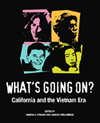![]() |
Current
Exhibitions |
Upcoming
Exhibitions |
|
Current
Exhibitions |
Upcoming
Exhibitions |
|
Off-site
Exhibitions |
Exhibition
Archive |
Welcome high school educators, These three lessons were developed as resources to enrich your teaching of the Vietnam War era at the 11th grade level. The lessons assume students have already conducted an introductory study of this historical period. They are based on research and primary source materials that were gathered during the creation of the special exhibition, What’s Going On?—California and the Vietnam Era. The lesson activities can occur over three days to two weeks depending upon the amount of research you want students to conduct on the topic.
Each of the
three lessons relates to how this era has shaped California and
U.S. history. These lessons need not be taught in any specific
sequential order, but rather should be used according to your classroom
needs and to supplement your curriculum. You will find
activities that engage students in critical thinking and historical
research, including oral histories and other rich resources. This
history will come alive for students as they discover the personal
stories of those who lived through this time. Students
are encouraged to explore the complexities of this period by
examining it from multiple perspectives. The lessons are
tied to the State of California Content Standards in History/Social
Science for grade 11. However you use these lessons, we hope you are able to further the discussion, and to engage your students in exploring the many sides of this controversial era. Oakland Museum of California Credits: Marcia Eymann,
project director, What’s Going On?—California
and the Vietnam Era and Content Specialist
PDFs require Adobe Reader, which is free to download and use “Any views, findings, conclusions, or recommendations expressed in this website do not necessarily reflect those of the National Endowment for the Humanities.” |
|||||
![]()
|
|
|
|
©
2006 Oakland Museum of California |

